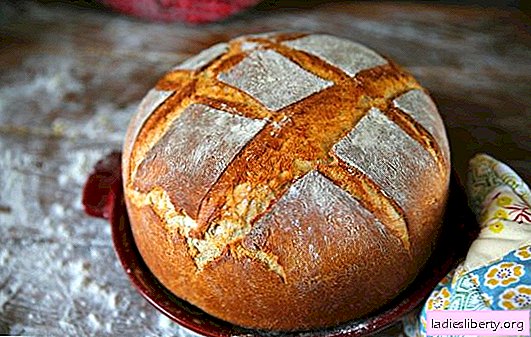
The smell of freshly baked bread is wonderful! Even better, if the taste did not disappoint. For some reason, often the bread does not rise, it turns raw inside or quickly becomes stale, crumbles incredibly when sliced. In fact, all this can be avoided; there is nothing complicated in cooking if you do not repeat frequent mistakes. How to do not need to?
Mistake One: Nepromes
Regardless of the recipe, you need to make a uniform and soft dough. Therefore, you should not simultaneously throw all the products in a bowl, fill in the liquid and try to prepare an elastic mass from all this. Nothing will work out, there will remain dense lumps inside, which are called "nepromes".
How to knead the dough:
- Yeast is bred in warm water. If sugar is used, then it is also immediately added along with a small portion of flour. The dough is left for some time to rise, if nothing else is specified in the instructions for the recipe.
- Dissolve salt in a small amount of warm water, it can be cast immediately before kneading the dough. Add to bulk.
- Next, add the remaining flour and butter (sometimes it goes to the dough), start kneading. If bran, seeds, grains, dried fruits, flakes are added to the bread, then they are also introduced at this stage, can be mixed with flour for even distribution.
How much to knead the dough? You need to work with your hands until the mass begins to lag behind the walls of the dishes. In appearance, it will become smooth, uniform, tuberosity will disappear.
By the way, if at home there is a mixer with a special spiral nozzle, then it can be safely used for kneading.
Mistake two: weak or sharp test consistency
If the dough is steep, then it will rise slowly and for a long time, the bread will turn out to be heavy, dense, and the next day it will crumble a lot when sliced. If the dough is too weak, then it will quickly acidify and rise, but after baking, a large hole may appear under the crust. Moreover, such a dough often falls, bread cannot be carefully placed in the oven, it is lowered and wrinkled.
Criteria for proper consistency:
- the dough does not spread to the sides, but eventually spreads a little on the table;
- it almost does not stick to hands;
- to make a figure out of the mass will not work.
If rye flour is added to the dough, then you can make the texture a little softer than when kneading on one wheat flour.
By the way, the exact amount of flour may not coincide with that indicated in the recipe, it all depends on the humidity of the ingredients.
Mistake Three: Small Acidity
You can’t rush with bread, the dough should gain the necessary acidity. If this does not happen, the taste will suffer, the baking will turn out stiff with small pores, it will quickly become hard. To speed up the process, often the dough is cooked with dough. Due to the weak consistency and a small amount of flour, the mass quickly approaches, gaining the necessary acidity, then the remaining ingredients are introduced into it.
How to accelerate the maturation of the test:
- lay the yeast in a warm liquid, dilute it carefully, you can leave it to swell in water for five or ten minutes;
- monitor the temperature in the room, it should not be lower than 22 degrees, it is better to catch up to 25;
- if it’s cool at home, you can put a bowl of dough in a pot of hot water;
- it is impossible to prevent the formation of a crust, therefore it is important to exclude drafts, and cover the vessel with bread dough with a napkin.
By the way, lay more yeast than specified in the recipe should not, they will spoil the taste of future bread, an unpleasant smell.
Important! Bread also does not like great acidity. If the dough persists, the crust will not fry, there may be problems with raising, and the finished bread has an unpleasant sour taste.
Fourth error: bread did not rise in shape
Lack of patience is the main problem of many housewives. The dough should rise well, not only in the total mass, but also in shape. Otherwise, you get a small loaf with a tight crumb, besides it will not be baked inside. A sign that the bread is not kept well in shape, are gaps along the perimeter under the upper crust.
How much test to put in the form? Usually they fill a container 1/2 height when baking dark bread from rye flour, it does not rise high. The mass is laid in 1/3 form using pure wheat flour dough. It is possible in the second version to fill up to the middle, just the bread will turn out higher, a rounded and ruddy hump will appear above the form.
By the way, to make the bread smooth and even on top, the dough must be rounded into a ball before laying in the mold, all seams should be located below.
Fifth error: wrong temperature selected
If you put the bread in an insufficiently warmed oven, then it simply dries in it. If, on the contrary, the temperature in the oven is high, then a crust forms quickly, the crumb does not have time to cook.
What to do:
- Plant bread at a temperature not lower than 230 degrees, the oven should warm up to this level.
- Immediately after planting, close the oven and lower the temperature to 180-200 degrees, depending on the size of the loaf. The larger it is, the lower the parameters.
On average, a loaf of bread of 0.5 kg is baked in the oven for 25 minutes. If sugar is present in the dough, then it will quickly cover with a golden crust. If there is only salt in the recipe, then the color will appear at the end of baking and it will not be bright.
Useful tips for perfect bread
- If suddenly the crust on the bread quickly browned or even started to burn, and the crumb did not cook, then the loaf should be covered with wet paper from above, periodically irrigated with water.
- To make the bread shiny on top, at the end of baking, you need to sprinkle it with water or grease a drop of oil after removing it from the oven.
- Bread continues to reach readiness even after baking, so there is no need to rush to remove it from the mold and break it. Let it stand for 15-20 minutes.
- If there is little salt in the test, then it will be fresh, tasteless, you need to lay strictly according to the recipe or a little more, but not less.
Conclusion
Making bread does not come down to a single instruction; it does not have the exact time of rise, a strictly defined amount of liquid or flour. You need to learn how to feel the dough, to understand its readiness, then no scales and thermometers are needed. Do not forget that bread (and the cooking process) should not be approached with a soul and in a good mood. Let baking absorb only positive energy!











